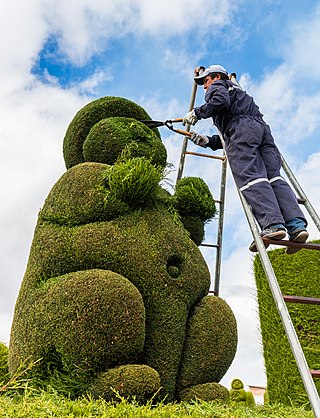
Gardening is the practice of growing and cultivating plants as part of horticulture. In gardens, ornamental plants are often grown for their flowers, foliage, or overall appearance; useful plants, such as root vegetables, leaf vegetables, fruits, and herbs, are grown for consumption, for use as dyes, or for medicinal or cosmetic use.
Vegetable farming is the growing of vegetables for human consumption. The practice probably started in several parts of the world over ten thousand years ago, with families growing vegetables for their own consumption or to trade locally. At first manual labour was used but in time livestock were domesticated and the ground could be turned by the plough. More recently, mechanisation has revolutionised vegetable farming with nearly all processes being able to be performed by machine. Specialist producers grow the particular crops that do well in their locality. New methods—such as aquaponics, raised beds and cultivation under glass—are used. Marketing can be done locally in farmer's markets, traditional markets or pick-your-own operations, or farmers can contract their whole crops to wholesalers, canners or retailers.
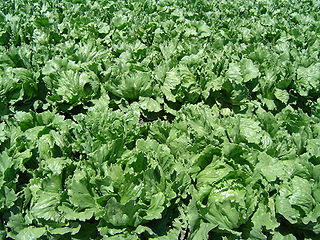
Lettuce is an annual plant of the family Asteraceae. It is most often grown as a leaf vegetable, but sometimes for its stem and seeds. Lettuce is most often used for salads, although it is also seen in other kinds of food, such as soups, sandwiches and wraps; it can also be grilled. One variety, celtuce, is grown for its stems, which are eaten either raw or cooked. In addition to its main use as a leafy green, it has also gathered religious and medicinal significance over centuries of human consumption. Europe and North America originally dominated the market for lettuce, but by the late 20th century the consumption of lettuce had spread throughout the world. As of 2021, world production of lettuce and chicory was 27 million tonnes, 53 percent of which came from China.
Spent mushroom compost is the residual compost waste generated by the mushroom production industry.
In agriculture, succession planting refers to several planting methods that increase crop availability during a growing season by making efficient use of space and timing.
Season extension in agriculture is any method that allows a crop to be grown beyond its normal outdoor growing season and harvesting time frame, or the extra time thus achieved. To extend the growing season into the colder months, one can use unheated techniques such as floating row covers, low tunnels, caterpillar tunnels, or hoophouses. However, even if colder temperatures are mitigated, most crops will stop growing when the days become shorter than 10 hours, and resume after winter as the daylight increases above 10 hours. A hothouse — a greenhouse which is heated and illuminated — creates an environment where plants are fooled into thinking it is their normal growing season. Though this is a form of season extension for the grower, it is not the usual meaning of the term.

A mulch is a layer of material applied to the surface of soil. Reasons for applying mulch include conservation of soil moisture, improving fertility and health of the soil, reducing weed growth, and enhancing the visual appeal of the area.
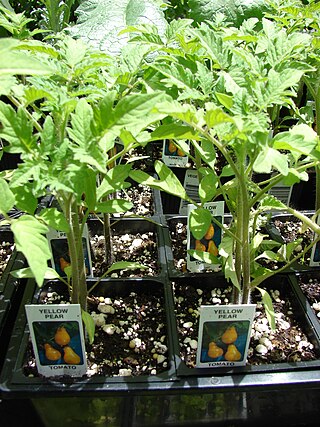
Plugs in horticulture are small-sized seedlings grown in seed trays filled with potting soil. This type of plug is used for commercially raising vegetables and bedding plants. Similarly plugs may also refer to small sections of lawn grass sod. After being planted, lawn grass may somewhat spread over an adjacent area.
Garden design is the art and process of designing and creating plans for layout and planting of gardens and landscapes. Garden design may be done by the garden owner themselves, or by professionals of varying levels of experience and expertise. Most professional garden designers have some training in horticulture and the principles of design. Some are also landscape architects, a more formal level of training that usually requires an advanced degree and often a state license. Amateur gardeners may also attain a high level of experience from extensive hours working in their own gardens, through casual study, serious study in Master gardener programs, or by joining gardening clubs.
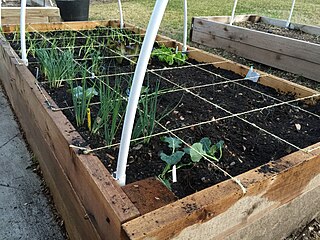
Square foot gardening is the practice of dividing the growing area into small square sections, typically 1 foot (30 cm) on a side, hence the name. The aim is to assist the planning and creating of a small but intensively planted vegetable garden. It results in a simple and orderly gardening system, from which it draws much of its appeal. Mel Bartholomew coined the term "square foot gardening" in his 1981 book of the same name.
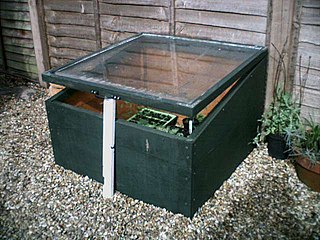
In agriculture and gardening, a cold frame is a transparent-roofed enclosure, built low to the ground, used to protect plants from adverse weather, primarily excessive cold or wet. The transparent top admits sunlight and prevents heat escape via convection that would otherwise occur, particularly at night. Essentially, a cold frame functions as a miniature greenhouse to extend the growing season.

Organic horticulture is the science and art of growing fruits, vegetables, flowers, or ornamental plants by following the essential principles of organic agriculture in soil building and conservation, pest management, and heirloom variety preservation.

Container gardening or pot gardening/farming is the practice of growing plants, including edible plants, exclusively in containers instead of planting them in the ground. A container in gardening is a small, enclosed and usually portable object used for displaying live flowers or plants. It may take the form of a pot, box, tub, basket, tin, barrel or hanging basket.
This is an alphabetical index of articles related to gardening.

A flowerpot, planter, planterette or plant pot, is a container in which flowers and other plants are cultivated and displayed. Historically, and still to a significant extent today, they are made from plain terracotta with no ceramic glaze, with a round shape, tapering inwards. Flowerpots are now often also made from plastic, metal, wood, stone, or sometimes biodegradable material. An example of biodegradable pots are ones made of heavy brown paper, cardboard, or peat moss in which young plants for transplanting are grown.

A keyhole garden is a two-meter-wide circular raised garden with a keyhole-shaped indentation on one side. The indentation allows gardeners to add uncooked vegetable scraps, greywater, and manure into a composting basket that sits in the center of the bed. In this way, composting materials can be added to the basket throughout the growing season to provide nutrients for the plants. The upper layer of soil is hilled up against the center basket, so the soil slopes gently down from the center to the sides. Most keyhole gardens rise about one meter above the ground and have walls made of stone. The stone wall not only gives the garden its form, but helps trap moisture within the bed. Keyhole gardens originated in Lesotho and are well adapted to dry arid lands and deserts. In Africa, they are positioned close to the kitchen and used to raise leafy greens such as lettuce, kale, and spinach; herbs; and root crops such as onions, garlic, carrots, and beets. Keyhole gardens are ideal for intensive planting, a technique in which plants are placed close together to maximize production. Plants with wide-reaching root systems, such as tomatoes and zucchini, may not perform well in a keyhole garden.
Sustainable landscaping is a modern type of gardening or landscaping that takes the environmental issue of sustainability into account. According to Loehrlein in 2009 this includes design, construction and management of residential and commercial gardens and incorporates organic lawn management and organic gardening techniques.
French intensive gardening also known as raised bed, wide bed, or French market gardening is a method of gardening in which plants are grown within a smaller space and with higher yields than other traditional gardening methods. The main principles for success are often listed as soil improvement, raised beds, close spacing, companion planting, succession planting and crop rotation. Originating in France, the practice is very popular among urban gardeners and small for profit farming operations.
There are many ways to garden in restricted spaces. Often a small or limited space is an issue in growing and cultivating plants. Restricted space gardens can be located on small lawns, balconies, patios, porches, rooftops, inside the home, or in any other available place. Gardening in small places can be applied to edible or floral plants. Growing food has many benefits including saving money; healthier, fresher, and better tasting food; knowledge of pesticide and fertilizer exposure. Gardening is a good form of exercise and has been proven to be therapeutic.

Hügelkultur, literally mound bed or mound culture is a horticultural technique where a mound constructed from decaying wood debris and other compostable biomass plant materials is later planted as a raised bed. Adopted by permaculture advocates, it is suggested the technique helps to improve soil fertility, water retention, and soil warming, thus benefitting plants grown on or near such mounds.


















